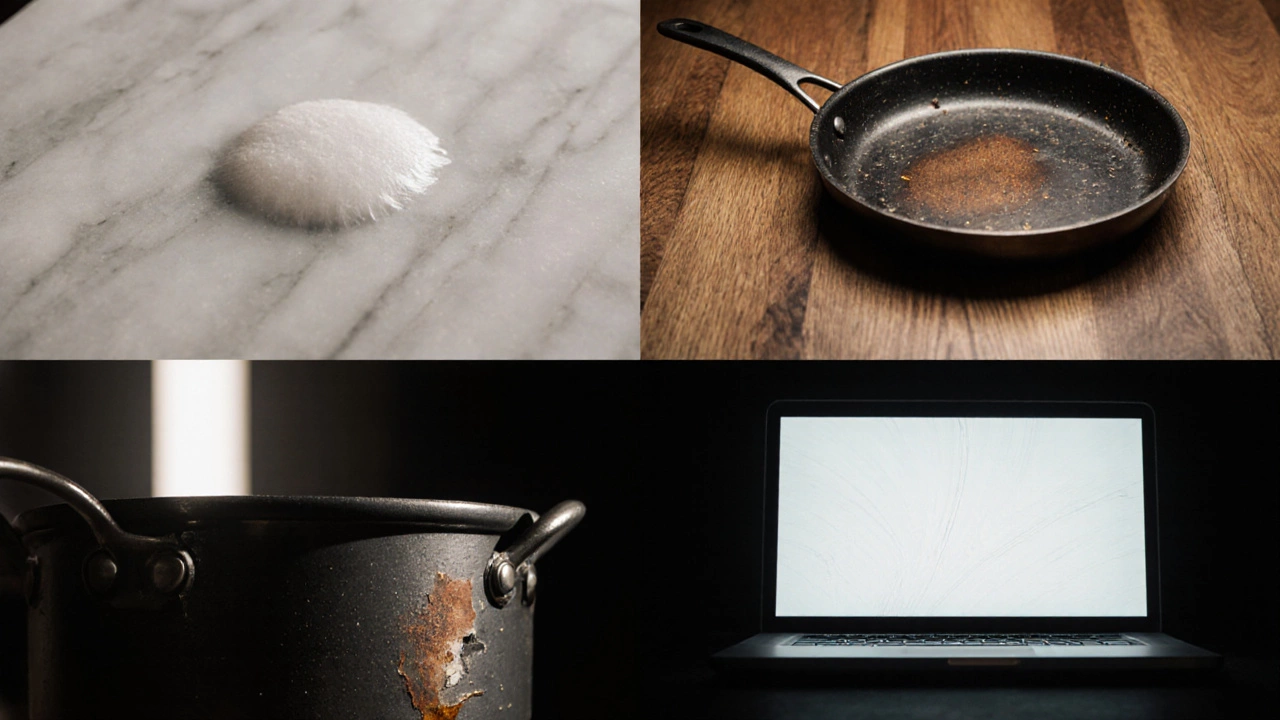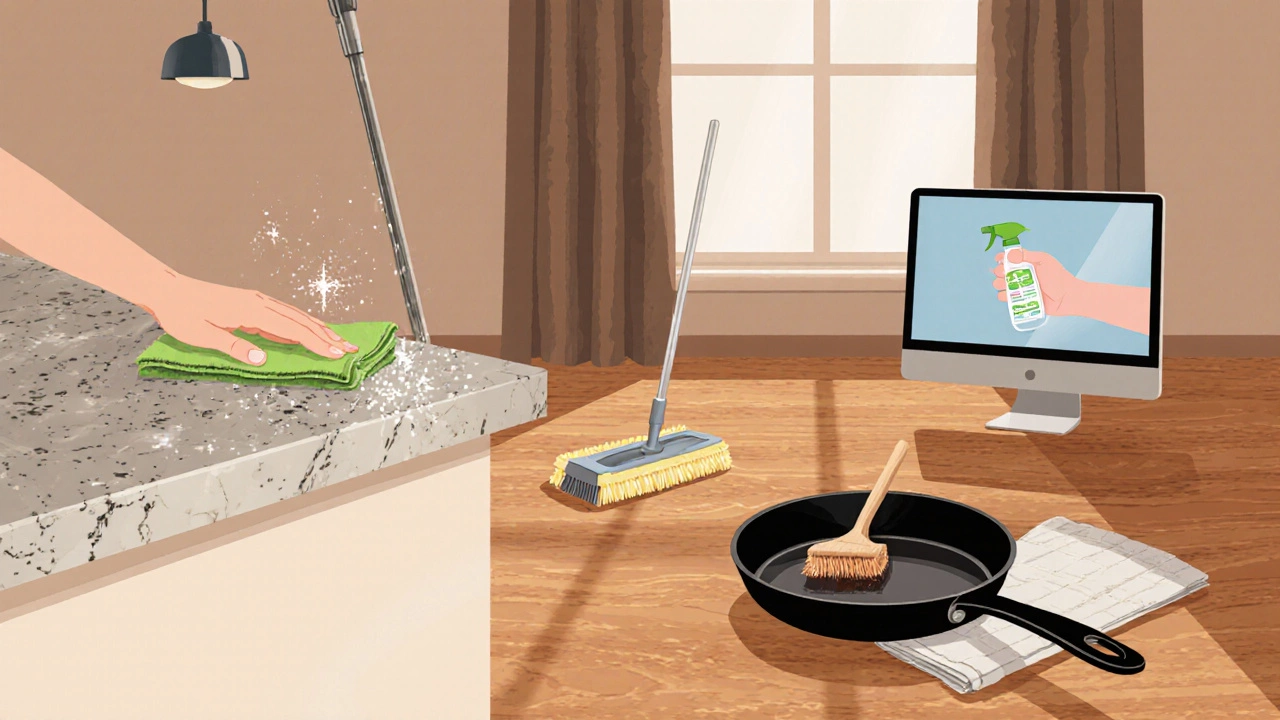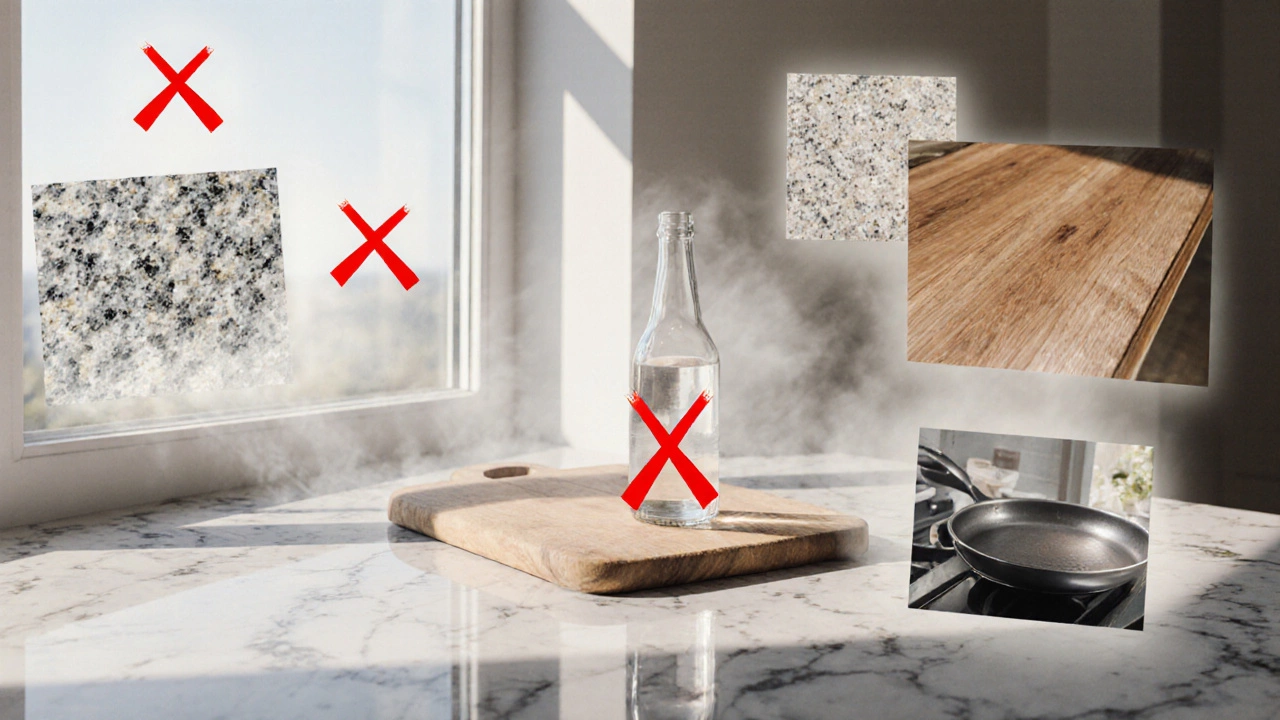Vinegar is the go‑to eco‑friendly cleaner for many households because it’s cheap, non‑toxic, and cuts through grime. But not every surface can handle the acidity of vinegar cleaning. Using it on the wrong material can leave permanent stains, etchings, or weaken finishes. Below is a practical guide that tells you exactly which surfaces to keep away from vinegar and what safer options you can reach for.
Quick Takeaways
- Never use vinegar on marble, granite, or any natural stone - the acid will etch the surface.
- Hardwood floors, especially those with wax or oil finishes, can become dull or warped.
- Cast iron, aluminum, and other reactive metals will corrode or develop rust‑like spots.
- Waxed, lacquered, or painted surfaces can lose their protective coating.
- Electronic screens, delicate fabrics, and specialty tiles should be cleaned with pH‑neutral products instead.
Why Vinegar Works - And When It Doesn’t
White distilled vinegar is a solution of about 5% acetic acid and 95% water. The acidity breaks down mineral deposits, grease, and mold, making it a superb all‑purpose cleaner. However, that same acidity is a chemical aggressor on materials that rely on a delicate finish or a calcium‑based composition.
Surfaces That React Badly to Vinegar
Marble, Granite, and Other Natural Stone
Marble is a calcium carbonate rock. When you apply vinegar, the acid reacts with calcium, causing a chemical etch that looks like a dull, cloudy spot. The same reaction occurs on Granite and other natural stones that contain calcium‑based sealants.
Once etched, the stone loses its shine and the damage is irreversible without professional polishing.
Hardwood Floors (Unsealed or Waxed)
Many older or budget hardwood floors are finished with a wax or oil coating. Vinegar’s acidity strips that finish, leaving the wood exposed to moisture. Over time the wood can warp, swell, or develop dark rings where the acid seeped in.
If you have a sealed hardwood floor, a mild vinegar solution may be safe, but always test in an inconspicuous spot first.
Cast Iron and Aluminum Cookware
Cast iron relies on a seasoned layer of polymerized oil to stay non‑stick and rust‑free. Vinegar dissolves that layer, exposing the raw iron, which rusts quickly. Aluminum reacts similarly; the acid eats away at the protective oxide layer, resulting in pitting and discoloration.
For stubborn rust on cast iron, a brief soak in a 1:1 water‑vinegar mix can help, but you must rinse thoroughly and re‑season immediately.
Waxed or Lacquered Surfaces
Furniture with a wax finish, lacquered cabinets, and certain metal fixtures are coated to protect against moisture. Vinegar dissolves these coatings, making the underlying material vulnerable to stains and water damage.
Painted Walls and Ceilings
Latex or oil‑based paint can handle mild cleaners, but vinegar’s acidity can cause paint to peel or lose its colour intensity, especially on glossy finishes.
LCD, LED, and Touchscreen Devices
Screen manufacturers warn against using acidic cleaners. Vinegar can eat away at the anti‑glare coating, leaving streaks that never fully disappear.
Delicate Fabrics and Upholstery
Silk, wool, and some synthetic blends lose their fibres when exposed to acid. A vinegar solution can cause colour bleeding or a stiff texture.
Specialty Tiles (e.g., Glazed Ceramic, Porcelain)
While many glazed tiles tolerate mild vinegar, those with a matte finish or natural stone look‑alikes can become dull or develop a chalky residue.

What Happens When Vinegar Damages a Surface?
The damage varies by material, but common signs include:
- Cloudy or milky spots on stone (etching).
- Loss of shine or a dull, matte finish on wood.
- Rust stains on metal.
- Peeling or flaking paint.
- Streaks and loss of touch‑sensitivity on screens.
In most cases, the cure is restoration or replacement, which can be costly compared to using the right cleaner from the start.
Safe Alternatives for Problem Surfaces
Stone Countertops
Use a pH‑neutral stone cleaner or a few drops of mild dish soap mixed with water. Buff with a microfiber cloth and seal the stone annually.
Hardwood Floors
For routine cleaning, sweep or vacuum, then mop with a solution of warm water and a few drops of hardwood‑floor cleaner. Avoid any acidic additives.
Cast Iron & Aluminum Cookware
Scrub with a non‑abrasive sponge and hot water. For rust, use a paste of baking soda and water, then re‑season cast iron immediately.
Waxed Furniture
Dust with a soft cloth, then apply a furniture polish that matches the finish. Avoid liquid cleaners altogether.
Painted Walls
A gentle mix of warm water and a few drops of mild dish soap works well. Spot‑test first, then wipe with a clean damp cloth and dry.
Electronic Screens
Use a screen‑safe cleaner (often a 70% isopropyl alcohol solution) applied to a microfiber cloth - never spray directly.
Delicate Fabrics
Hand‑wash with a gentle detergent in cool water, or use a fabric‑specific spray approved by the manufacturer.
Specialty Tiles
Stick to a neutral floor cleaner that’s labelled safe for tile, or simply use warm water and a soft mop.

Tips for Using Vinegar Safely
- Always dilute: a 1:1 ratio with water works for most hard, non‑porous surfaces.
- Label your spray bottle clearly to avoid accidental misuse.
- Test in a hidden spot before applying to the whole area.
- Avoid prolonged contact - spray, wipe, and rinse if possible.
- Keep vinegar away from children and pets; it’s safe but the smell can be strong.
Quick Reference Checklist
| Surface | Vinegar OK? | Suggested Alternative |
|---|---|---|
| Stainless steel appliances | Yes (diluted) | Dish soap solution |
| Marble countertops | No | Stone‑specific pH‑neutral cleaner |
| Hardwood floors (sealed) | Conditional | Hard‑floor cleaner |
| Cast iron skillet | No (except brief rust removal) | Hot water & brush, re‑season |
| LCD monitor | No | Screen‑safe microfiber wipe |
| Painted wall | No (acidic paint) | Mild soap & water |
Frequently Asked Questions
Can I use vinegar on glass shower doors?
Yes. A 1:1 water‑vinegar mix removes hard water spots without harming the glass. Wipe dry to avoid streaks.
Is apple cider vinegar any different from white distilled vinegar for cleaning?
Both have about the same acidity (5%). Apple cider vinegar adds a faint colour and scent, but it’s equally harsh on stone and metal.
What if I already etched my marble with vinegar?
You’ll need a professional stone polishing service. DIY polishing compounds may improve the look, but they won’t fully restore the original shine.
Can I mix vinegar with baking soda for cleaning?
The reaction produces carbon dioxide fizz, which can help lift grime, but it also neutralises the acid. Use this combo only on surfaces that tolerate neutral pH, like tiles or tubs.
Is there a safe way to clean my stainless steel fridge with vinegar?
Yes, spray a diluted solution, wipe with a soft cloth, then buff with a dry microfiber towel. The acid removes fingerprints without harming the finish.
By remembering which surfaces hate vinegar, you can keep your home sparkling while protecting valuable finishes. Stick to the right cleaner for the right job, and you’ll avoid costly repairs and preserve the look of every room.
